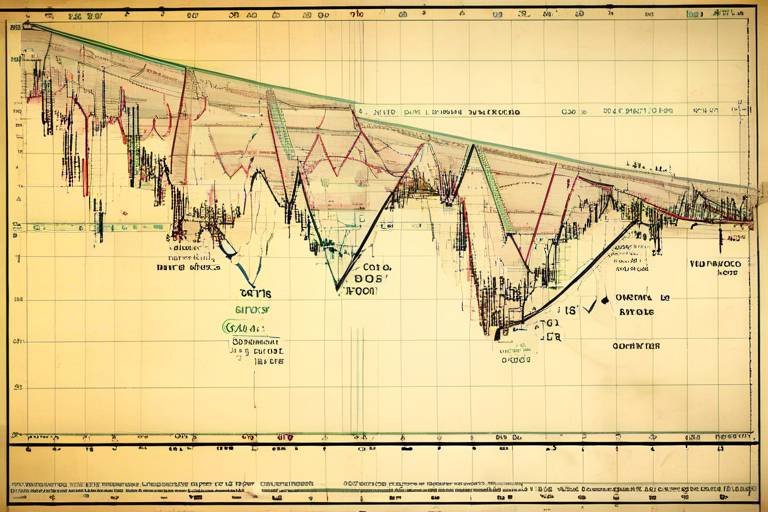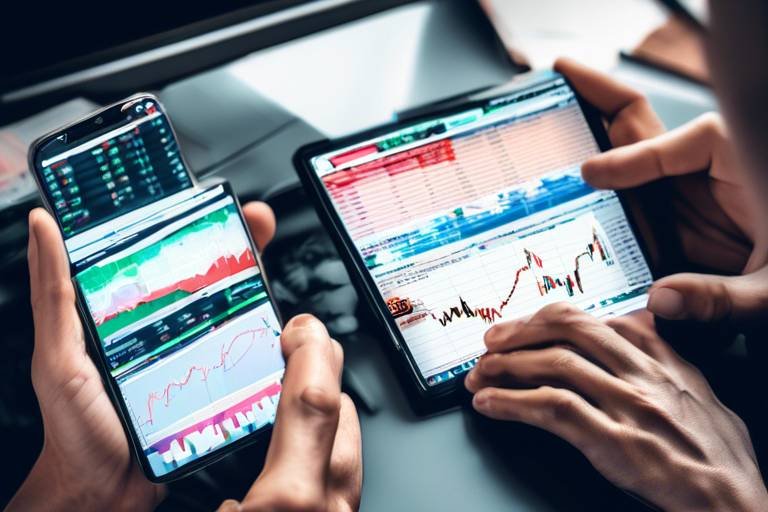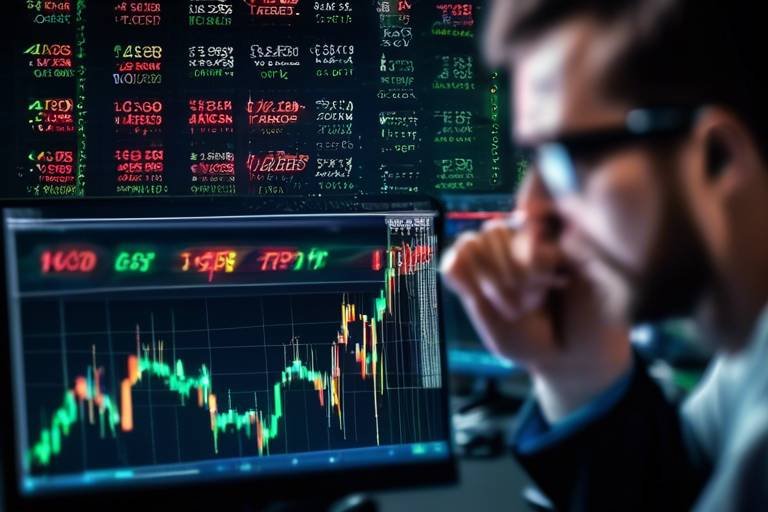The Best Strategies for New Crypto Traders
Entering the world of cryptocurrency trading can feel like stepping into a vast ocean, full of both opportunities and treacherous waves. For new traders, it’s crucial to equip yourself with the right strategies to navigate this exciting yet volatile market. This article explores effective strategies for beginner crypto traders, providing insights into market analysis, risk management, and trading psychology to enhance trading success.
A solid foundation in cryptocurrency is essential for new traders. Before diving into trading, it's important to grasp key concepts such as blockchain technology, which serves as the backbone of cryptocurrencies. This decentralized ledger enables secure and transparent transactions, allowing users to trust the system without needing a central authority. Additionally, familiarize yourself with different types of cryptocurrencies, including Bitcoin, Ethereum, and altcoins, each with unique features and purposes. Understanding how the market operates, including the factors that influence price fluctuations, is also crucial for making informed decisions.
Selecting a reliable cryptocurrency exchange is crucial for your trading journey. Think of it as choosing a bank for your money; you want to ensure it's safe and user-friendly. Consider factors such as security, where exchanges with two-factor authentication and cold storage options should be prioritized. Additionally, keep an eye on fees associated with trading, withdrawals, and deposits, as these can eat into your profits. A smooth user experience is equally important; you want a platform that is easy to navigate, especially when market conditions change rapidly. Researching user reviews and ratings can provide valuable insights into the reliability of an exchange.
Understanding market analysis is vital for making informed trading decisions. There are two primary types of analysis: fundamental analysis and technical analysis. Fundamental analysis involves examining the underlying factors that can affect a cryptocurrency's value, such as its utility, technology, and market demand. On the other hand, technical analysis focuses on historical price movements and trading volumes, using charts and indicators to predict future price trends. By combining both methods, you can gain a more comprehensive view of market conditions and make well-informed trades.
A well-defined trading plan is essential for success. Think of it as your roadmap in the chaotic world of crypto trading. An effective plan should include components such as entry and exit strategies, which outline when to buy or sell based on your analysis. Additionally, incorporate risk management techniques to protect your investments. This could involve setting stop-loss orders to limit potential losses and defining the maximum amount of capital you are willing to risk on any single trade. Lastly, setting realistic goals ensures that you stay focused and avoid the emotional rollercoaster that often comes with trading.
Managing risk is critical in crypto trading. The market's inherent volatility can lead to significant losses if not approached carefully. Here are a few key risk management techniques:
- Diversification: Spread your investments across different cryptocurrencies to mitigate risk.
- Position Sizing: Determine the appropriate amount to invest in each trade based on your overall portfolio size.
- Stop-Loss Orders: Set predetermined sell orders to automatically close positions if a cryptocurrency's price drops to a certain level.
By employing these strategies, you can protect your investments and enhance your chances of long-term success.
Emotional discipline is key to successful trading. The psychological aspects of trading can often lead to poor decision-making, especially during times of market volatility. Common emotional pitfalls include fear of missing out (FOMO) and panic selling. To maintain a rational mindset, it’s essential to stick to your trading plan and avoid making impulsive decisions based on emotions. Techniques such as mindfulness and journaling can help you reflect on your trades and understand your emotional triggers, leading to better decision-making in the future.
Keeping up with market trends is essential for traders. The cryptocurrency landscape is continuously evolving, influenced by news, market sentiment, and technological advancements. Follow reputable news sources and engage with the community to stay informed about the latest developments. Social media platforms and forums can also provide valuable insights and discussions that may impact your trading decisions. By staying updated, you can make timely and informed choices that align with the current market landscape.
Engaging with other traders can provide valuable insights. Think of it as joining a club where everyone shares their knowledge and experiences. Participating in trading communities, forums, and social media groups can enhance your trading knowledge and strategies. Networking with experienced traders can also offer mentorship opportunities and access to exclusive resources. By building a community, you not only gain support but also expand your understanding of the market.
Q: What is the best strategy for a beginner in crypto trading?
A: The best strategy is to start with a solid understanding of the market, choose a reliable exchange, and develop a comprehensive trading plan while managing risks effectively.
Q: How much money should I invest as a beginner?
A: It's advisable to start with an amount you can afford to lose. This helps mitigate the emotional stress associated with trading and allows you to learn without significant financial pressure.
Q: Is it necessary to learn technical analysis?
A: While not mandatory, learning technical analysis can significantly enhance your trading skills, helping you make informed decisions based on historical price trends.
Q: How can I stay updated on market trends?
A: Follow reputable news sources, join trading communities, and engage in forums to stay informed about the latest developments and market sentiment.

Understanding Cryptocurrency Basics
Before diving into the thrilling world of cryptocurrency trading, it's crucial to build a solid foundation by understanding the basics. Think of cryptocurrency as the digital gold of the 21st century. Just like gold, cryptocurrencies are valuable, but they operate in a completely different realm—one that is decentralized and driven by technology. At the heart of this revolution is blockchain technology, which acts as a public ledger that records all transactions across a network of computers. This means that every transaction is transparent and immutable, ensuring trust and security in a world where traditional financial systems often fall short.
Now, let's break down some key concepts that every new trader should grasp:
- Blockchain Technology: This is the backbone of all cryptocurrencies. It's a decentralized database that securely records transactions in blocks, which are then linked together in a chain. Imagine it as a digital filing cabinet where each drawer (block) contains records (transactions) that are permanently locked in place.
- Types of Cryptocurrencies: While Bitcoin is the most well-known, there are thousands of cryptocurrencies available today—each with its unique features and purposes. For instance, Ethereum allows for smart contracts, while Ripple focuses on facilitating international money transfers. Understanding these differences can help you choose which cryptocurrencies to invest in.
- Market Operation: The cryptocurrency market operates 24/7, unlike traditional stock markets. Prices can fluctuate wildly in a matter of minutes, driven by factors such as investor sentiment, news, and regulatory developments. This constant movement can be both exhilarating and daunting for new traders.
As a beginner, you might feel overwhelmed by all this information, but don’t worry! Just like learning to ride a bike, it takes practice and patience. Start by familiarizing yourself with the most popular cryptocurrencies and their underlying technologies. There are plenty of resources available, from online courses to forums, where you can learn from experienced traders. Additionally, consider following reputable news sources and platforms that specialize in cryptocurrency updates to stay informed about market trends and developments.
In conclusion, understanding the basics of cryptocurrency is not just beneficial; it's essential for your trading success. By grasping key concepts like blockchain technology, the variety of cryptocurrencies, and how the market operates, you’ll be better equipped to navigate the often turbulent waters of crypto trading. Remember, every expert was once a beginner, so take your time, do your research, and soon enough, you'll be ready to make informed trading decisions!

Choosing the Right Exchange
When it comes to diving into the world of cryptocurrency trading, one of the most critical decisions you'll make is choosing the right exchange. Think of it as picking the right vehicle for a road trip; you want something reliable, safe, and suited to your journey. With so many options available, it can feel overwhelming, but fear not! We’ll break down the essential factors to consider, ensuring you make an informed choice that aligns with your trading goals.
First off, security should be at the top of your list. The cryptocurrency market is notorious for hacks and scams, so you want an exchange that prioritizes the safety of your assets. Look for exchanges that offer two-factor authentication (2FA), cold storage for funds, and a solid track record of security. A good way to gauge an exchange's reputation is to read reviews and check for any past security breaches. Remember, if an exchange has been hacked before, it’s a red flag!
Next, consider the fees associated with trading on the exchange. Different platforms have varying fee structures, which can significantly impact your profits. Some exchanges charge a flat fee per trade, while others take a percentage of the transaction. Additionally, watch out for hidden fees, such as withdrawal fees or deposit fees. It’s essential to calculate these costs to understand how they will affect your overall trading strategy. For instance, if you plan to trade frequently, a platform with lower transaction fees might be more beneficial.
Another crucial factor is the user experience. A well-designed, intuitive interface can make your trading journey much smoother. If you’re a beginner, you might prefer an exchange that offers a simple layout and easy navigation. On the other hand, more experienced traders might look for advanced charting tools and features. It’s worth taking the time to explore different platforms and see which one feels right for you. Many exchanges offer demo accounts, allowing you to practice trading without risking real money.
Additionally, consider the variety of cryptocurrencies offered on the exchange. While Bitcoin and Ethereum are the most popular, many traders seek opportunities in altcoins. If you have specific coins in mind, ensure that the exchange supports them. A diverse selection can also provide you with more trading options, allowing you to diversify your portfolio.
Lastly, don’t overlook the importance of customer support. In the fast-paced world of crypto trading, you may encounter issues or have questions that need immediate attention. Check if the exchange has a responsive support team, and explore the various communication channels available, such as live chat, email, or phone support. A reliable support system can save you a lot of headaches down the line.
In summary, choosing the right cryptocurrency exchange requires careful consideration of several factors, including security, fees, user experience, available cryptocurrencies, and customer support. Taking the time to research and compare different platforms can make a significant difference in your trading success. So, buckle up and enjoy the ride, but remember to choose your vehicle wisely!
- What is the most secure cryptocurrency exchange? The most secure exchange often depends on user experience, but platforms like Coinbase and Binance are known for their robust security measures.
- How do I know if an exchange has high fees? Review the fee schedule on the exchange's website, and compare it with other platforms to see how it stacks up.
- Can I trade on multiple exchanges? Yes, many traders use multiple exchanges to take advantage of different features and lower fees.
- What should I do if I have a problem with my exchange? Contact the customer support team of the exchange immediately for assistance.

Market Analysis Techniques
Understanding market analysis is vital for making informed trading decisions in the ever-evolving world of cryptocurrency. As a new trader, you might feel overwhelmed by the sheer volume of information available. However, breaking it down into two primary categories—fundamental analysis and technical analysis—can help simplify the process and enhance your trading strategy.
Fundamental analysis involves evaluating a cryptocurrency's intrinsic value by examining various factors that could influence its price. This includes looking at the project's technology, team, market demand, and regulatory environment. For instance, if a new blockchain technology promises to improve transaction speeds significantly, this could lead to increased adoption and, consequently, a rise in the coin's value. You should also pay attention to news events, partnerships, and developments within the crypto space that could impact prices. A strong understanding of these elements can help you make better predictions about future price movements.
On the other hand, technical analysis focuses on price charts and trading volumes to forecast future price movements based on historical data. By analyzing patterns and trends, traders can identify potential entry and exit points. Here are some common tools used in technical analysis:
- Charts: Line charts, bar charts, and candlestick charts provide visual representations of price movements over time.
- Indicators: Tools like Moving Averages, Relative Strength Index (RSI), and MACD help traders gauge market momentum.
- Support and Resistance Levels: Identifying these levels can help traders understand where prices are likely to reverse or break through.
To effectively utilize technical analysis, you should familiarize yourself with chart patterns such as head and shoulders, double tops/bottoms, and triangles. These patterns can signal potential market reversals or continuations. Moreover, combining both fundamental and technical analysis can provide a more comprehensive view of the market, allowing you to make well-rounded trading decisions.
As you embark on your trading journey, remember that practice makes perfect. Utilize demo accounts to hone your skills without risking real money. By continuously learning and adapting your strategies based on market conditions, you’ll be better equipped to navigate the complexities of crypto trading.
Q: What is the difference between fundamental and technical analysis?
A: Fundamental analysis focuses on the underlying factors that can affect a cryptocurrency's value, while technical analysis studies price movements and patterns to predict future prices.
Q: How can I start practicing technical analysis?
A: You can start by using demo trading accounts on various exchanges, studying price charts, and familiarizing yourself with different indicators and chart patterns.
Q: Is it necessary to use both analysis techniques?
A: While it's not mandatory, combining both fundamental and technical analysis can provide a more holistic view of the market and improve your trading decisions.

Developing a Trading Plan
Creating a solid trading plan is like crafting a roadmap for your journey into the world of cryptocurrency. It’s essential for navigating the often volatile and unpredictable market. Just as a traveler wouldn’t set off on an adventure without a map, you shouldn’t jump into trading without a well-defined strategy. A trading plan outlines your goals, strategies, and the rules you’ll follow to achieve success while minimizing risk.
First and foremost, your trading plan should include entry and exit strategies. Think of these as your checkpoints along the way. When will you buy? When will you sell? Defining these points in advance helps you avoid making impulsive decisions driven by emotions. For instance, let’s say you decide to buy Bitcoin when it dips below a certain price point and sell when it reaches a predetermined profit level. This approach not only provides clarity but also instills confidence in your trading decisions.
Next, consider the importance of risk management. This is where the rubber meets the road, as it can make or break your trading success. A good rule of thumb is to only risk a small percentage of your total trading capital on any single trade—typically around 1% to 3%. By doing this, you protect your overall investment from significant losses. You might also want to incorporate stop-loss orders into your plan. These are like safety nets that automatically sell your assets if they fall below a certain price, preventing further losses.
Additionally, setting realistic goals is crucial. It’s easy to get caught up in the hype and dream of making millions overnight, but the reality is often much different. Instead, focus on achievable targets that reflect both your risk tolerance and market conditions. For example, aim for a consistent percentage return on your investments each month rather than an unrealistic expectation of doubling your capital every week. This mindset will help you remain grounded and focused on long-term growth.
Lastly, it’s important to regularly review and adjust your trading plan. The crypto market is constantly evolving, and what works today might not be effective tomorrow. Periodically evaluate your strategies and results. Are you meeting your goals? Are there new trends or tools you should consider? By staying flexible and adapting your plan as necessary, you can enhance your chances of success in the dynamic world of cryptocurrency trading.
- What is a trading plan? A trading plan is a comprehensive strategy that outlines your trading goals, entry and exit points, risk management techniques, and overall approach to trading.
- Why is risk management important? Risk management helps protect your capital from significant losses, allowing you to trade more confidently and sustainably over the long term.
- How often should I review my trading plan? It’s advisable to review your trading plan regularly—at least once a month or after significant market movements—to ensure it remains effective and relevant.

Risk Management Strategies
When diving into the thrilling world of cryptocurrency trading, one of the most crucial aspects to consider is risk management. Think of it as your safety net while you navigate the unpredictable waves of the crypto market. Just like a seasoned sailor knows to check the weather before setting sail, you too must have effective strategies in place to protect your investments from unforeseen storms.
One of the fundamental techniques in risk management is diversification. This means spreading your investments across various cryptocurrencies instead of putting all your eggs in one basket. Imagine you have a portfolio that consists of Bitcoin, Ethereum, and a couple of altcoins. If one coin takes a nosedive, the others might still perform well, helping to cushion your losses. A well-diversified portfolio can significantly reduce your exposure to risk.
Another critical aspect to consider is position sizing. This refers to determining how much of your capital you should allocate to a particular trade. A common rule of thumb is to risk only a small percentage of your total trading capital on any single trade—typically around 1% to 2%. By doing so, you can withstand a series of losses without jeopardizing your entire trading account. It’s like playing poker; you wouldn’t bet your whole stack on a single hand, right?
Moreover, utilizing stop-loss orders is an effective way to manage risk. A stop-loss order automatically sells your cryptocurrency when it reaches a certain price, limiting your potential losses. For example, if you purchase Bitcoin at $40,000 and set a stop-loss at $38,000, your position will automatically close if the price drops to that level. This strategy not only protects your investment but also helps you maintain emotional discipline by removing the need for constant monitoring of your trades.
To further enhance your risk management strategy, consider implementing a trailing stop-loss. This is a dynamic version of the traditional stop-loss, allowing you to lock in profits as the price moves in your favor. For instance, if Bitcoin rises from $40,000 to $45,000, a trailing stop-loss can be set to sell if it falls back to $43,000, ensuring that you secure some profits while still allowing for potential gains.
Let’s not forget the importance of maintaining a solid trading journal. Keeping track of your trades, including the rationale behind each decision, can provide invaluable insights into your trading behavior. Over time, you might notice patterns in your trading that can help you refine your strategies. It’s like having a personal coach who helps you learn from both your successes and mistakes.
In conclusion, effective risk management strategies are integral to your success as a crypto trader. By diversifying your portfolio, managing your position sizes, utilizing stop-loss orders, and maintaining a trading journal, you can significantly mitigate risks and increase your chances of achieving long-term profitability. Remember, the goal isn’t just to make money but to protect what you already have while navigating the exciting world of cryptocurrencies.
- What is the most important risk management strategy for new traders?
Diversification is crucial as it helps spread risk across different assets. - How can I determine my position size?
A good rule is to risk only 1% to 2% of your total capital on any single trade. - What is a stop-loss order?
A stop-loss order automatically sells your asset when it reaches a predetermined price to limit losses. - Should I use a trailing stop-loss?
Yes, it can help you lock in profits while allowing for potential gains as the price moves in your favor.

Emotional Discipline in Trading
When it comes to trading in the volatile world of cryptocurrency, emotional discipline is often the unsung hero behind many successful trades. Imagine standing in front of a roller coaster, heart racing, adrenaline pumping, and the thrill of the ride is just a few moments away. That’s what trading can feel like—exciting yet terrifying. For many new traders, the emotional highs and lows can lead to impulsive decisions that derail their trading strategies. So, how can you keep your cool amidst the chaos?
First and foremost, it's essential to recognize that emotions can cloud your judgment. Fear and greed are two of the most powerful emotions in trading. Fear can cause you to sell too early or avoid entering a trade altogether, while greed might push you to hold onto a position longer than you should, hoping for that elusive peak. To combat these emotions, you need to develop a strong sense of self-awareness. Ask yourself, “Am I making this decision based on data and analysis, or is it driven by my feelings?” This simple question can help you regain control.
One effective strategy for maintaining emotional discipline is to establish a set of trading rules that you adhere to without exception. These rules should be based on your trading plan and include specific guidelines for entering and exiting trades, as well as how much capital you are willing to risk. For instance, you might decide that you will never invest more than 5% of your total capital in a single trade. By sticking to these rules, you create a framework that helps you make rational decisions, even when your emotions try to take the wheel.
Another crucial aspect of emotional discipline is understanding the concept of loss aversion. Research shows that people tend to feel the pain of losses more intensely than the pleasure of gains. This inherent bias can lead traders to hold onto losing positions in the hope that they will bounce back, resulting in even greater losses. Instead, consider implementing stop-loss orders. These are predefined points at which you will exit a trade to limit your losses. By doing so, you take the emotion out of the equation and stick to your plan.
Moreover, practicing mindfulness can greatly enhance your emotional discipline. Mindfulness techniques, such as meditation or deep-breathing exercises, can help you stay grounded and focused. When you find yourself feeling overwhelmed by market fluctuations, taking a moment to breathe and refocus can prevent rash decisions. Remember, trading is a marathon, not a sprint. It’s about making consistent, informed decisions over time rather than chasing every market movement.
Lastly, it’s important to learn from your mistakes. Every trader experiences losses, but what separates successful traders from the rest is their ability to analyze their missteps and adjust their strategies accordingly. Keep a trading journal where you document your trades, the emotions you felt during each, and the outcomes. Reflecting on these entries can provide valuable insights into your emotional triggers and help you develop stronger discipline.
- What is emotional discipline in trading? Emotional discipline refers to the ability to manage your emotions and make rational decisions in trading, rather than reacting impulsively to market fluctuations.
- How can I improve my emotional discipline? You can improve your emotional discipline by setting strict trading rules, practicing mindfulness, and maintaining a trading journal to learn from your experiences.
- Why is emotional discipline important in trading? Emotional discipline is crucial because it helps you avoid making impulsive decisions that can lead to significant losses, allowing you to stick to your trading plan and achieve long-term success.

Staying Informed on Market Trends
Keeping your finger on the pulse of the cryptocurrency market is absolutely crucial for any trader looking to thrive in this fast-paced environment. Imagine trying to navigate a ship through the stormy seas without a compass—this is what trading without current market insights feels like. Staying informed not only helps you make better trading decisions but also allows you to anticipate market movements and adjust your strategies accordingly. So, how can you stay updated? Let's dive into some effective methods!
First and foremost, news sources play a pivotal role in your trading journey. Subscribing to reputable cryptocurrency news websites will keep you in the loop about market changes, regulatory news, and technological advancements. Some popular sources include:
- CoinDesk
- CoinTelegraph
- The Block
- CryptoSlate
These platforms provide timely articles and expert opinions that can help you understand the broader market context. Additionally, consider following industry leaders and influencers on social media platforms like Twitter and LinkedIn. Their insights can often provide a unique perspective on market trends that you won't find in traditional news outlets.
Moreover, joining cryptocurrency forums and communities can significantly enhance your understanding of market sentiment. Websites like Reddit and specialized Discord channels are goldmines for discussions about upcoming trends, potential scams, and hot topics within the crypto community. Engaging in these discussions not only boosts your knowledge but also allows you to connect with fellow traders who share their experiences and strategies.
Another vital aspect of staying informed is keeping an eye on market sentiment indicators. These tools gauge the overall mood of the market, helping you to understand whether traders are feeling optimistic or pessimistic. For instance, the Fear and Greed Index is a popular tool that can provide insights into market psychology. If the index shows extreme fear, it might be a good time to buy, while extreme greed could signal a market correction. Understanding these indicators can give you a significant edge in your trading strategy.
Lastly, don't underestimate the importance of technical analysis. Familiarizing yourself with chart patterns, volume indicators, and price movements can help you make more informed decisions. Websites like TradingView offer extensive charting tools that allow you to analyze historical data and predict future trends. By integrating technical analysis into your trading routine, you'll be better equipped to spot opportunities and avoid potential pitfalls.
In conclusion, staying informed on market trends is not just an option; it's a necessity for any serious crypto trader. By leveraging news sources, engaging with communities, monitoring market sentiment, and utilizing technical analysis, you can navigate the turbulent waters of cryptocurrency trading with confidence. Remember, knowledge is power, and in the world of crypto, it can be the difference between profit and loss!
Q: How often should I check market news?
A: It's advisable to check market news regularly throughout the day, especially when you're actively trading. However, setting aside dedicated time each day to review updates can help you stay informed without becoming overwhelmed.
Q: What are some reliable sources for cryptocurrency news?
A: Some trustworthy sources include CoinDesk, CoinTelegraph, and The Block. Additionally, social media platforms can provide real-time insights from industry experts.
Q: How can I gauge market sentiment?
A: You can use tools like the Fear and Greed Index or follow discussions in crypto communities to get a sense of market sentiment. Observing trading volumes and price movements can also provide clues.
Q: Is technical analysis necessary for beginners?
A: While it may seem complex, basic technical analysis can greatly enhance your trading decisions. Many resources are available to help beginners learn the fundamentals.

Building a Community and Networking
In the dynamic world of cryptocurrency, building a community and networking with fellow traders can be a game-changer for your trading experience. Imagine navigating the often turbulent waters of crypto trading without a compass—this is what trading alone can feel like. Engaging with others not only provides you with a support system but also opens doors to a wealth of knowledge and insights that you might not discover on your own.
So, where do you start? The first step is to seek out trading communities that resonate with your interests and trading style. Online forums, social media groups, and dedicated trading platforms are fantastic places to connect with like-minded individuals. For example, platforms like Reddit, Twitter, and Discord have thriving crypto communities where traders share tips, discuss market trends, and even provide emotional support during market downturns. Being part of such communities can help you feel less isolated and more empowered in your trading journey.
Moreover, participating in discussions can enhance your understanding of the market. You’ll find that others often share their experiences, strategies, and mistakes, which can be incredibly valuable for your own learning. Just think about it: learning from someone else's costly mistake can save you a lot of time and money!
Networking doesn’t just stop at online interactions. Attending crypto meetups and conferences can be a fantastic way to meet traders in person. These events often feature expert speakers, workshops, and panels that can deepen your knowledge while providing opportunities to connect with industry leaders and fellow traders. Plus, who knows? You might just meet your next trading partner or mentor!
It’s also essential to engage actively in these communities. Don’t just lurk in the shadows; share your thoughts, ask questions, and contribute to discussions. This not only builds your reputation but also fosters relationships that can lead to collaborative opportunities. Remember, the crypto space is vast, and there’s always something new to learn, so why not learn it together?
In addition to online forums and in-person events, consider joining trading groups on platforms like Telegram or WhatsApp. These groups often provide real-time updates and discussions, which can be crucial for making timely trading decisions. However, it’s important to choose groups wisely. Look for communities that promote healthy discussions and discourage pump-and-dump schemes. Trust and integrity should be at the forefront of any community you choose to engage with.
Finally, always be open to new ideas and perspectives. The crypto market is constantly evolving, and what worked yesterday might not work today. By networking and building a community, you expose yourself to a range of strategies and insights that can refine your trading approach. In essence, the more you connect with others, the more equipped you’ll be to navigate the ever-changing landscape of cryptocurrency trading.
- Why is community important for crypto traders? Community provides support, knowledge sharing, and networking opportunities that can enhance your trading skills.
- How can I find crypto trading communities? Look for groups on social media platforms, forums like Reddit, or attend local meetups and conferences.
- What should I avoid in trading communities? Be cautious of groups that promote unethical practices like pump-and-dump schemes or provide misleading information.
- Can networking lead to mentorship opportunities? Absolutely! Networking can connect you with experienced traders who can offer guidance and mentorship.
Frequently Asked Questions
- What is cryptocurrency?
Cryptocurrency is a digital or virtual form of currency that uses cryptography for security. Unlike traditional currencies, cryptocurrencies operate on technology called blockchain, which is a decentralized ledger that records all transactions across a network of computers.
- How do I choose a cryptocurrency exchange?
Choosing the right cryptocurrency exchange is crucial. Look for factors such as security measures, transaction fees, user interface, and customer support. It's also wise to read reviews and check the exchange's reputation within the trading community.
- What are the different types of market analysis?
There are two primary types of market analysis: fundamental analysis and technical analysis. Fundamental analysis involves evaluating a cryptocurrency's value based on factors like technology, team, and market demand, while technical analysis focuses on price movements and trading volumes using charts and indicators.
- Why is a trading plan important?
A trading plan is essential because it outlines your trading strategies, including entry and exit points, risk management techniques, and financial goals. Having a plan helps you stay disciplined and makes it easier to make informed decisions rather than emotional ones.
- What are some effective risk management strategies?
Effective risk management strategies include diversifying your portfolio to spread risk, determining position sizes based on your total capital, and using stop-loss orders to limit potential losses. These techniques help protect your investments from significant downturns.
- How can I maintain emotional discipline while trading?
Maintaining emotional discipline is crucial for successful trading. To do this, set clear goals, stick to your trading plan, and avoid making impulsive decisions based on market emotions. Practicing mindfulness and keeping a trading journal can also help you reflect on your trades and improve your mindset.
- Why is it important to stay informed about market trends?
Staying informed about market trends allows you to make timely and educated decisions. Following news, market sentiment, and technological advancements can provide insights into potential price movements, helping you capitalize on opportunities and avoid pitfalls.
- How can I connect with other traders?
Connecting with other traders can enhance your knowledge and strategies. You can join online forums, participate in social media groups, or attend local meetups. Engaging with a community of traders helps you share experiences, tips, and insights that can benefit your trading journey.



















